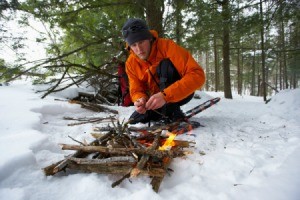
This page contains the following solutions.
You're stranded in your car or truck in the middle of winter and you have no winter survival kit in your car. No relief in sight. This TP heater may save your life. This requires a empty coffee can with the plastic lid, at least two 16 ounce bottles of rubbing alcohol and one roll of unscented toilet paper. It's easy to make:
This tip came from a friend, a woodsman and war reenactor. Works amazingly well, but takes some prep. You should prepare this fire starter kit before you have to rely upon it off the beaten track. You may also want to keep the kit in a waterproof pouch or ziplock baggie when backpacking, just in case.
Supplies:
Steps:
You may want to practice this technique before having to rely on it. It takes some setup, but all your tools can fit into the Altoids tin and travel with you as a "frontier" fire starter kit.
Your old lighters can be used to strike up a fire.
Source: My friend, Forrest Wilson, woodsman and carpenter.
Cobwebs contain many disinfectants, including penicillin. If you're in the wilderness and someone (or yourself) has been cut badly, wrap clean cobwebs around the wound and cover with a clean cloth.
Here are the questions asked by community members. Read on to see the answers provided by the ThriftyFun community.
Is this a plant that grows in the US and if so, what types of environments does it grow in? Also, I looked it up and pretty much everywhere it says not to eat it. This may just be modern opinion, however, since he said that if you cook the tubers in the coals of a campfire for a few minutes, it'll sap the minor toxins from the roots and it's like eating sweet potatoes.
Hardiness Zone: 5a
Paul from Houghton, NY
I am no expert in identifying, or using poisonous plants for food in a wilderness survival situation, but here is what I know about Celandine.
There are two types of Celandine, Greater Celandine, and Lesser Celandine (Chelidonium majus and Ranunculus ficaria L., respectively). Parts of both plants are toxic and both have been used for medicinal purposes, but despite their similar names (and yellow flowers), these two plants are not at all related. Parts of both plants contain toxic compounds and historically, both have been used for medicinal purposes. What the video host was charring on the campfire was most likely the Lesser Celandine, which is still looked at as a valuable wildflower in many parts of Europe, Asia, and North Africa.
Lesser Celandine is now naturalized (considered a noxious weed, actually) in parts of the U.S. and Canada. According to the USDA, in North America its current distribution is limited to 19 states across the Pacific Northwest, northern Midwest, and northeastern portions of the United States, as well as parts of eastern and western Canada.
A herbaceous perennial, Lesser Celandine inhabits moist forested floodplains and prefers sandy soil. This is the same habitat you find native Marsh Marigolds growing, which is probably why the two are often confused. Lesser Celandine blooms early in the spring and unlike the Marsh Marigold, which grows in individual clusters, it forms dense mats that sometimes crowd out the native species. For this reason, it is on the Federal list of noxious weeds.
Historically, Lesser Celandine have been used for medicinal purposes, primarily as an astringent and in the treatment of hemorrhoids and ulcers. Although all parts of this plant are considered poisonous (including the bulbils, leaves, sap and flowers), the toxins are said to be unstable and easily destroyed by heat. If properly prepared, the roots, leaves, stems and flowers can all be safely eaten. That said, I would not recommend eating Celandine unless:
1) You are certain you can identify it.
2) You know how to properly prepare it in order to destroy the toxins.
Here are some good resources if you would like more information.
Good luck!
Ellen
I would contact your local botanic garden or botanic society to be on the safe side--however, here are some results of a quick search:
Lesser Celandine:
Greater Celandine:
**webpages.charter.net/
"Celandine Chelidonium majus Attractive, self-sowing perennial herb, prefers moist soil and light shade. Anti-inflammatory and cleansing, used internally (with caution) & externally (warts, tumors, eye problems)"
** www.theherbaladvisor.com/
"This is another great herb for improving bile flow and many skin conditions that are caused by lack of essential fatty acids, such as eczema and psoriasis. This plant is undoubtedly the true Celandine, having nothing in common with the Lesser Celandine except the colour of its flowers. It was a drug plant in the Middle Ages and is mentioned by Pliny, to whom we owe the tradition that it is called Chelidonium from the Greek chelidon (a swallow), because it comes into flower when the swallows arrive and fades at their departure. Its acrid juice has been employed successfully in removing films from the cornea of the eye, a property which Pliny tells us was discovered by swallows, this being a double reason why the plant should be named after these birds."